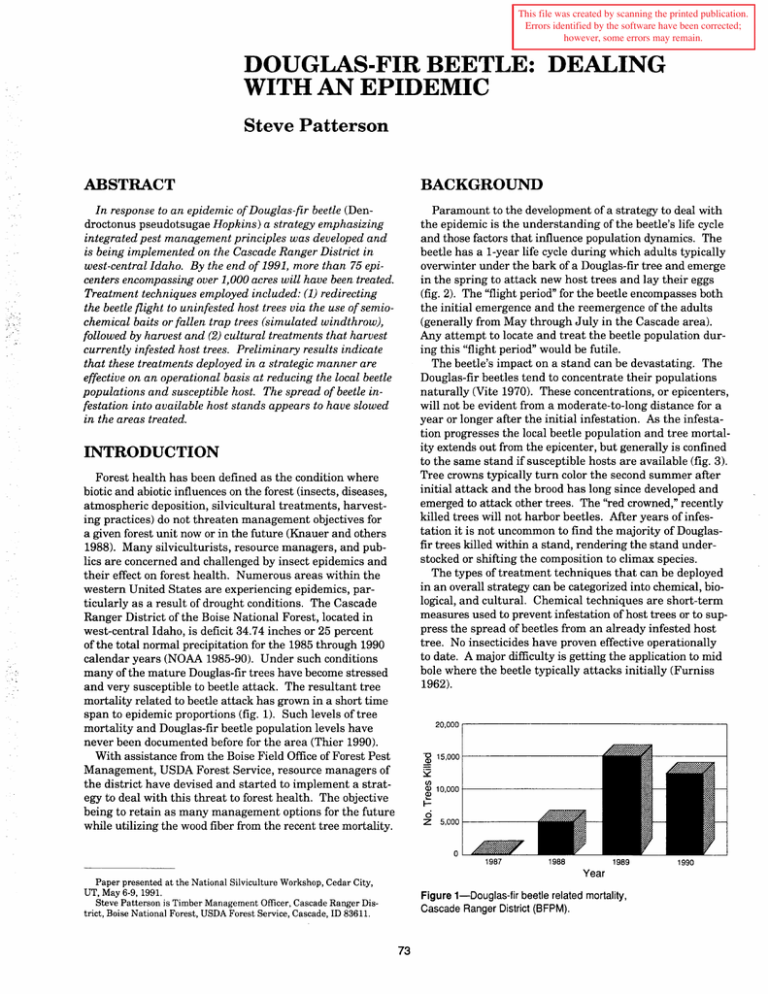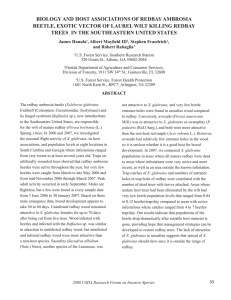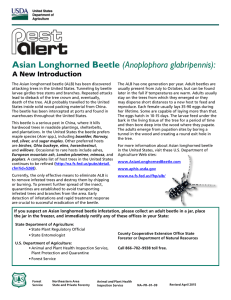DOUGLAS-FIR BEETLE: DEALING WITH AN EPIDEMIC Steve Patterson ABSTRACT
advertisement

This file was created by scanning the printed publication. Errors identified by the software have been corrected; however, some errors may remain. DOUGLAS-FIR BEETLE: DEALING WITH AN EPIDEMIC Steve Patterson ABSTRACT BACKGROUND In response to an epidemic of Douglas-fir beetle (Dendroctonus pseudotsugae Hopkins) a strategy emphasizing integrated pest management principles was developed and is being implemented on the Cascade Ranger District in west-central Idaho. By the end of 1991, more than 75 epicenters encompassing over 1,000 acres will have been treated. Treatment techniques employed included: (1) redirecting the beetle flight to uninfested host trees via the use of semiochemical baits or fallen trap trees (simulated windthrow), followed by harvest and (2) cultural treatments that harvest currently infested host trees. Preliminary results indicate that these treatments deployed in a strategic manner are effective on an operational basis at reducing the local beetle populations and susceptible host. The spread of beetle infestation into available host stands appears to have slowed in the areas treated. Paramount to the development of a strategy to deal with the epidemic is the understanding of the beetle's life cycle and those factors that influence population dynamics. The beetle has a I-year life cycle during which adults typically overwinter under the bark of a Douglas-fir tree and emerge in the spring to attack new host trees and lay their eggs (fig. 2). The "flight period" for the beetle encompasses both the initial emergence and the reemergence of the adults (generally from May through July in the Cascade area). Any attempt to locate and treat the beetle population during this "flight period" would be futile. The beetle's impact on a stand can be devastating. The Douglas-fir beetles tend to concentrate their populations naturally (Vite 1970). These concentrations, or epicenters, will not be evident from a moderate-to-Iong distance for a year or longer after the initial infestation. As the infestation progresses the local beetle population and tree mortality extends out from the epicenter, but generally is confined to the same stand if susceptible hosts are available (fig. 3). Tree crowns typically turn color the second summer after initial attack and the brood has long since developed and emerged to attack other trees. The "red crowned," recently killed trees will not harbor beetles. After years of infestation it is not uncommon to find the majority of Douglasfir trees killed within a stand, rendering the stand understocked or shifting the composition to climax species. The types of treatment techniques that can be deployed in an overall strategy can be categorized into chemical, biological, and cultural. Chemical techniques are short-term measures used to prevent infestation of host trees or to suppress the spread of beetles from an already infested host tree. No insecticides have proven effective operationally to date. A major difficulty is getting the application to mid bole where the beetle typically attacks initially (Furniss 1962). INTRODUCTION Forest health has been defined as the condition where biotic and abiotic influences on the forest (insects, diseases, atmospheric deposition, silvicultural treatments, harvesting practices) do not threaten management objectives for a given forest unit now or in the future (Knauer and others 1988). Many silviculturists, resource managers, and publics are concerned and challenged by insect epidemics and their effect on forest health. Numerous areas within the western United States are experiencing epidemics, particularly as a result of drought conditions. The Cascade Ranger District of the Boise National Forest, located in west-central Idaho, is deficit 34.74 inches or 25 percent of the total normal precipitation for the 1985 through 1990 calendar years (NOAA 1985-90). Under such conditions many of the mature Douglas-fir trees have become stressed and very susceptible to beetle attack. The resultant tree mortality related to beetle attack has grown in a short time span to epidemic proportions (fig. 1). Such levels of tree mortality and Douglas-fir beetle population levels have never been documented before for the area (Thier 1990). With assistance from the Boise Field Office of Forest Pest Management, USDA Forest Service, resource managers of the district have devised and started to implement a strategy to deal with this threat to forest health. The objective being to retain as many management options for the future while utilizing the wood fiber from the recent tree mortality. 20,000 r - - - - - - - - - - - - - - - - - - - - - , ~ 15,000 i: (JJ ~ 10,0001--------------1 t= ci Z 5,000 o f------- 1987 1988 1989 Year Paper presented at the National Silviculture Workshop, Cedar City, UT, May 6-9, 1991. Steve Patterson is Timber Management Officer, Cascade Ranger District, Boise National Forest, USDA Forest Service, Cascade, ID 83611. Figure 1-Douglas-fir beetle related mortality, Cascade Ranger District (BFPM). 73 1990 The technique is deployed similarly to the "trap tree" technique, as another form of attractant. Baits are readily available commercially ($3.67/bait, 1990 price). A semipermeable plastic bag, with two vials of chemicals in it, is stapled to the north side of an uninfested Douglas-fir tree. Funnel traps are devices hung in the forest that use a ''bait'' to lure beetles into a series of plastic funnels, which the beetle cannot crawl out of. The technique is very effective at killing beetles, but does not address the host problem. Intensity of bait deployment is two per acre (Thier and Weatherby 1991). The advantage of baits over trap trees is the feasibility and expense of setting up the attractant. The rule-of-thumb is that a baited or trap tree area will attract beetles within one-quarter mile. The repellent Methylcyclohexenone (MCH) has shown potential for use as an antiaggregant to prevent infestation of live trees (Furniss and others 1972; Rudinsky and others 1972; McGregor and others 1985). The material is currently subject to the Environmental Protection Agency's registration and is only available under an experimental use permit. Should the material become available operationally it would be effective as a short-term measure in protecting high-value areas, such as developed campgrounds, from infestation. Cultural techniques include the full range of silvicultural treatments. These techniques are long-term measures that emphasize manipulation of the host. Any treatment that stimulates vigor, or changes stand composition, can dramatically affect the susceptibility of the stand to Douglas-fir beetle attack. In order to "risk rate" susceptibility of stands, a fairly crude modeling system used average Douglas-fir tree diameter, total stand density, percentage of Douglasfir of total density, and age of stand as parameters (BFPM 1984). Should the treatments be timed so that harvest of the stand occurs when beetles occupy some of the trees, then the local beetle population and the potential for spread of the epicenter will be reduced. OVERWINTERING ADULTS Figure 2-Life cycle of Douglas-fir beetle. Biological techniques that have merit in this situation include the use of attractants and/or baits followed by harvest and repellants. A strong attractant to a beetle is a fresh windthrown tree. This can be simulated by felling "trap trees" into shaded areas during the late fall or winter. After the flight period has concluded the downed trees are removed for harvest and the beetles are destroyed in the milling process. Synthesized behavior-modifying chemicals emulate naturally occurring pheromones. They can be placed on a noninfested host tree to ''bait'' the beetles to attack that tree and adjacent trees. DISCUSSION Stand Tree t MAY -JULY (green crown) t£. . . .:,. (fading crown) 'rJ (red crown) ~A Epidemics are dependent primarily on three general factors: presence of the pest, available hosts, and environmental conditions (Furniss and Carolin 1977; Hoffman 1991). In this situation, the beetle population and the amount of susceptible Douglas-fir stands are the two parameters that can be manipulated by a strategic plan. Many factors such as impacts to visual, water, and wildlife resources, as well as the suitable timber base, had to be considered in developing a strategic plan for the district. The objectives or criteria that were developed as a result of the plan are: (1) attempt to slow the epidemic in areas where current or future timber sales are active or planned within the next 5 years, (2) salvage merchantable mortality, (3) leave the stand in a viable condition, silviculturally, for long-term health and growth, and (4) treatments will be within accepted thresholds, such that future management options and/or nontimber resources are not impaired. Folding all of this into a credible, effective analysis and assessment conforming to the intent of the National Environmental Policy Act (NEPA) is challenging. Two large planning areas (15,000+ acres) and several small, localized FAll.. 2ND SUMMER 3RDSUMMER (no crown) Figure 3-Tree/stand signs of beetle attack. 74 Table 1-lmplemented and proposed actions centers of beetle activity were analyzed. The documents for the larger planning areas were designed to provide flexibility, so that after the "flight" in spring actions could be taken to respond to new epicenters that either may not have been detected in an earlier inventory or are actually a new occurrence. This resulted in Environmental Assessments (EA) that were 80 percent site specific. The scope of treatment acres was higher than the actual known areas at the time the Decision Notice was signed. Environmentally conservative "sideboards" were set for these additional acres of treatment. A review/feedback loop with the original Interdisciplinary Team was also established in order to assess the site specific information for any additional proposed treatment against the intent of the EA. The duration of the EA was to be 1 year. Another key component of the district's strategy was to work with the purchasers of timber sales under contract that have moderate or highly susceptible stands with or without current beetle activity adjacent or within the designated units. Utilizing the "catastrophic" provisions in the contract, harvest schedules were adjusted and attractant techniques were used wherever the silvicultural systems were compatible. The treatment techniques used in the strategic plan were biological and cultural. The majority of situations resulted in a prescription of a regeneration method that was prefaced by attracting to and/or retaining the beetles in the confines of the harvest unit. Within priority areas, a network of baits and/or trap trees was established in an attempt to direct flights. Figure 4 depicts how the various treatment techniques were deployed within the Moores Creek area of the Westside Salvage Sale Planning Area. Not all stands with beetle activity were treated, yet treatments were utilized to attract beetles to units planned for harvest. Table 1 summarizes the treatments implemented in 1990 and those planned for 1991 on the district. Years and sales Acre 1990 1991 l 280 Eastside Salv TS Other sales Sales under contract 250 90 84 105 809 No. Acre 40 80 50 60 35 150 40 20 120 255 was sampled in four treatment units. Of the 35 baited trees sampled all were attacked to some degree and 85 of the 197 host trees within 1 chain of the sampled baited trees were also infested (Lokker 1990). This confirms general observations and the literature that the baits are very effective at attracting beetles. Results of the verification monitoring will come with time. Annual aerial detection flights of the district will be studied to determine if the priority treatment areas show mortality trends that are significantly different from untreated areas. Observations of the effect of having attractant techniques deployed adjacent to untreated epicenters will also be made and analyzed to see if beetles can be redirected away from active areas. Several casual observations seem to indicate that this is happening. SUMMARY By the end of calendar year 1990, the district's strategic plan to deal with a forest health issue, brought about by drought and the ensuing epidemic of Douglas-fir beetle, will have treated more than 75 epicenters encompassing over 1,000 acres of moderate to highly susceptible host stands. Some untreated adjacent epicenters appear to have dwindled significantly in terms of tree mortality. Hopefully the epidemic has been slowed in priority treatment areas. Time will tell. In order to assist such efforts in the future the following are needed: (1) improved understanding of succession and ability to "risk rate" stands, (2) continued public education about succession, (3) operational registration of synthesized antiaggregant chemicals, and (4) better methodologies and emphasis for monitoring treatment effects. Implementation, effectiveness, and verification monitoring are being conducted throughout the areas of treatment. The effectiveness of synthesized pheromone baits ~. Westside Sal v TS Other sales Sales under contract Totals RESULTS -,"' Attractant followed by cultural treatment Bait/log Trap/log Salvage actiVi~ beetle bait followed by cultural, trap IOQS I 3~~~~ REFERENCES Boise Field Office, Forest Pest Management, 1987-1990. Flight Detection Surveys. USDA For. Servo Intermountain Region. Boise Field Office, Forest Pest Management, 1984. Douglasfir Beetle Hazard Rating, Unpublished. USDA For. Servo Intermountain Region. Furniss, R. L., V. M. Carolin, 1977. Western Forest Insects. Misc. Publication No. 1339, USDA For. Servo Figure 4--1 red!mt::lll It::(;iuliques implemented in Moores Creek, Westside Planning Area. 75 Furniss, M. M. 1962. Infestation patterns of Douglas-fir beetle in standing and windthrown trees in southern Idaho. J. Econ. Entomol. 55: 486-491. Furniss, M. M.; Kline, L. N.; Schmitz, R. F.; Rudinsky, J. A. 1972. Tests of three pheromones to induce or disrupt aggregation of Douglas-fir beetles in live trees. Ann. Entomol. Soc. Amer. 65: 1227-1232. Hoffman, J. 1991. Personal communication. Boise Field Office, Forest Pest Management, USDA For. Servo Intermountain Region. Knauer, K.; G. Mason, et al. 1988. Forest Health Through Silviculture and Integrated Pest Management: A Strategic Plan. USDA For. Servo Lokker, R. 1990. Monitoring results of bait effectiveness, Westside Planning Area. Unpublished. USDA For. Servo Cascade Rang. Dist. Boise National Forest. McGregor, M. D.; Oakes, R. D.; Meyer, H. E. 1985. Evaluation of Douglas-fir mortality from Douglas-fir beetle from 1982 through 1984 following MCH application. USDA For. Servo Northern Region Rpt. 85-7. National Oceanic and Atmospheric Administration. 19851990. Climatological Data, McCall, Idaho Thier, R. W. 1990. Personal Conversation. USDA For. Servo Intermountain Region. Thier, R. W.; J. C. Weatherby. Accepted for publication 1990. Mortality of Douglas-fir after Two Semiochemical Baiting Treatments for Douglas-fir Beetle (Coleoptera: Scolytidae). J. ofEcon. Entomology. Rudinsky, J. A.; Furniss, M. M.; Kline, L. N.; R. F. Schmitz. 1972. Attraction and repression of Dendroctonus pseudotsuga (Coleoptera: Scolytidae) by three synthetic pheromones in sticky traps in Oregon and Idaho. Can. Entomol. 104: 815-822. Vite, J. P. 1970. Pest management systems using synthetic pheromones. Contrib. Boyce Thompson Inst. 24: 343-350. 76




